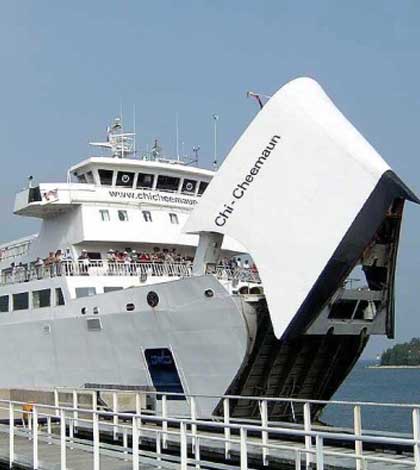OWEN SOUND—The Chi-Cheemaun passenger statistics for the 2014 season are complete, and the numbers continue to drop, but the reduction in the numbers are far from drastic considering the late start to the season and the marketing hit taken by the lack of followup by some media outlets.
“It could have been a lot worse,” admitted Owen Sound Transportation Company (OSTC) CEO Susan Schrempf. “The vehicle traffic was down 2.79 percent and the walk-on passenger numbers were down about eight percent over 2012.”
The official statistics show that there were a total of 66,385 vehicles making the crossing on the ferry this year and 166,224 walk-on passengers. The walk-on passengers included 21,919 adults and 2,959 children, while drive-on numbers included 123,513 adults and 17,833 children.
The OSTC is currently putting together plans to turn around the usage statistics on the ferry, but they are not yet finalized, noted Ms. Schrempf. “We are still putting together the pieces,” she said.
“We had a very successful evening with our first dining and entertainment outing in October,” she noted, with the event selling out. The current plan is to offer at least one such evening a month in the 2014 season, with at least one beginning on Manitoulin.
The dinner and entertainment evenings take place over the entire return transit of the ferry. “On the way out dinner is served and on the way back there is entertainment,” said Ms. Schrempf.
Another concept will be to offer return walk-on fares. “Although it won’t necessarily have to be same day returns for the walk-ons,” she said.
A website will enable ferry travellers to book a package deal with resort owners and receive a discount on their accommodation and fare. “The website will have a map showing the destinations,” she said. The program has proven popular with a number of Island resorts already.
Turning around the usage numbers on the ferry will require a combined effort from both the ferry and local tourism stakeholders, noted Ms. Schrempf. “But it is also going to require some patience. This is not all going to take place overnight.”
The CEO noted that the expectation is that there will be a large number of small things happen that will bring a total value-added approach to the ferry. A consultant’s report earlier last year noted that the ferry can no longer depend on its role as a transportation link to increase and augment its passenger numbers, but that the ferry must become a tourism experience in itself, bolstered by strategic combinations with other stakeholders to create a complete experiential package that will draw passengers in its own right.
Ms. Schrempf said that she is confident the numbers utilizing the ferry will increase. “You will not see a dramatic rise, so we caution people not to expect a 50 percent jump in the numbers the first year,” she said. “This will take a regional effort.”
A marketing company is expected to be hired to assist in bringing greater awareness of the ferry and its new offerings, but that is also still a work in progress.





